What reason was there in raising the stone, in elevating the sacred beyond the ground and, between the physical and the metaphysical, in creating paths that led towards desires for eternity? The menhirs of Sardinia traced obscure routes, enigmatic to the eyes of us, human beings of today. Stone is essential, and in its hardness difficult to penetrate; so could be the intentions, ideas, and common feeling of those men who, first of all, decided to shape the world. Anthropomorphic statuary spread at the same time in Lunigiana, Valle d’Aosta and many other parts of Europe, but in Sardinia it assumed greater importance, declining through local and fascinating facets.

The menhirs of Sardinia, male symbols of fertility
At the end of the Neolithic period, in the second half of the 4th millennium B.C., aniconic menhirs appeared on the island, vertical stones set in the ground, monoliths that were not at all hewn, but rough in their mysterious geometry. Those earlier signs were the vanguard of a new way of conceiving the world. They expressed, for the people of the Ozieri culture1, and perhaps even before of the San Ciriaco culture2, a spiritual tension towards the territory, now interpreted as a living space in which to circumscribe one’s existence.
The emergence of menhirs indicated the changing relationship with the land, a benign and generous mother but, in those Neolithic communities devoted to agriculture, also to be governed through an ideal fecundation. These monoliths, called pedras fittas in Sardinian language, therefore symbolised a male principle3; the fertility of the fields was to be promoted by mimicking the mechanism of procreation4.
The emergence of male symbols in pre-Neolithic cultures reflects the period when different clans were competing with each other for natural resources. This implied the need to establish and defend their possessions, not infrequently by warfare, which was the prerogative of male individuals. Thus, the idea of marking the ground with vertical and visible markers – some menhirs in Sardinia are over five metres high – served to claim a sort of sacred primogeniture of the territory. At the same time, the monolith symbolised the totem of the community, which defined the affiliation of its members. This is the case of the aniconic menhir of Monte d’Accoddi (3500-3300 B.C.), around which a settlement developed and, over some centuries, the well-known sanctuary area with its terraced altar was built.

The protoanthropomorphic menhirs
It is difficult today to understand the spiritual tension, the cultural and anthropological reasons that led the ancient Sardinians of the Ozieri culture to mould the rock into more complex forms and symbolism. The proto anthropomorphic menhirs did not yet have human features, but they communicated thoughts and words, they manifested the living presence of matter, of the transcendent essence that made the land fertile. They began to assume an ogival or sub-ogival shape, and the flat front surface was polished by slow and patient hammering. Stone upon stone, then, a reflection of a reality that did not include the superfluous.
Apparently, those stone figures do not have the expressive force that characterises the more evolved anthropomorphic statues. However, nothing excludes the possibility that the human figure was also represented through painting, perhaps using the red ochre that was so full of meaning for Neolithic peoples. The carefully flattened front face of the menhirs could be a clue, if not proof, as it was well prepared for the application of a pictorial layer. In any case, such a surface probably had some ritual function. At Is Cirquittus of Laconi, it was covered with a series of cup-marks, evidence of rituals involving the donation of an offering to mother earth.
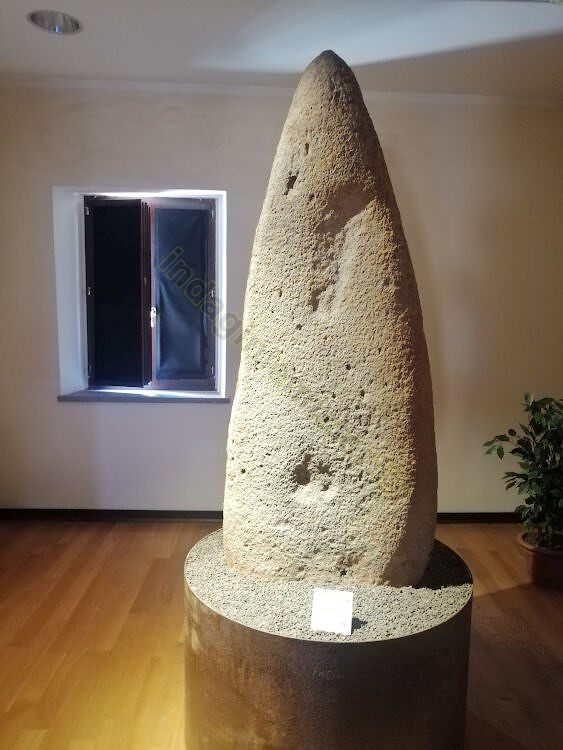
Ancestor worship in the menhirs of Sardinia
Menhirs became anthropomorphic when the shape of the stone was modelled to form a silhouette. The head and shoulders of a human figure were outlined, the first features of a face shyly appeared. This particular form of art reflected the desire to bring man closer to stone. It was a powerful metaphor through which to make eternal and incorruptible what is instead transitory, mortal. Anthropomorphic menhirs were images of men for eternity, sacred ancestors and deified heroes who found refuge there from oblivion, thus remaining in the memory of posterity. They settled in that time and place and, as watchful guardians, they became guiding spirits, those who show the way.

This made it possible to historicise the possession of a given territory, to sacralise it in order to claim its inheritance. Members’ belonging to the community was thus defined not only in the present moment but through family or tribal lineage.
Sacred alignments
Lithic representations of ancestors sometimes constituted sanctuary areas. Similar to ancient forests, the monoliths of pre-Nuragic Sardinia were erected in groups or arranged in long, fascinating rows, as if to demarcate the sacred territory over which they were to stand guard. These cultic centres, consisting of several close alignments, provided a physical and metaphysical order to nature. In other words, they allowed it to be overwritten to make it more predictable, more familiar. This is the essence of rituals, which through the reiteration of gestures, such as the laying of stone blocks, could bring existence out of chaos, allowed the fear of the unknown to be processed. This had to be accompanied by an oral semantics, unknowable today, necessary to codify the ritual, so as to give it the desired extra-empirical efficacy.
“The signs are mythograms linked to particular and complex ceremonies in which iterated words and litanies pronounced in front of the community have an important significance”.
M. Perra, Le statue antropomorfe prima dei nuraghi. In the book: A. Moravetti, P.Melis, L. Foddai, E. Alba, La Sardegna Preistorica, Corpora delle antichità della Sardegna, 2017, Carlo Delfino editore & C., Author’s translation.
The alignments followed strict spatial criteria, perhaps related to the observation of the sky. This is the impression one gets when walking among the menhirs of Biru ‘e Concas in Sorgono.
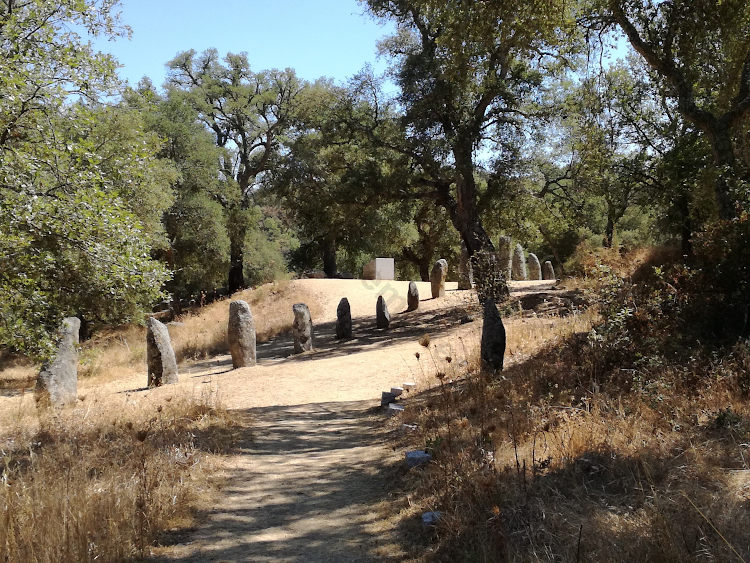
The archaeological site of Biru ‘e Concas in Sorgono
The archaeological complex is of primary importance for the study of the megalithic phenomenon in Sardinia. It houses around one hundred and ten monoliths of various types: mostly aniconic and proto anthropomorphic, but also an anthropomorphic menhir and some stele statues with daggers. Most of the menhirs of Biru ‘e Concas were aligned along two precise lines, oriented on the north-south axis5, demonstrating some sacred significance that is still unclear. The cultic importance that the site of Sorgono had in antiquity can be deduced from the uninterrupted use of the area for more than a thousand years, between the Recent Neolithic (3400-2800 BC) and the Copper Age (2800-1900 BC), according to the clay materials found6. In this vast lapse of time, several settlements belonging to the cultures of Ozieri, Abealzu and Monte Claro were established, to which the megalithic enclosure that delimits the sacred area belongs7.
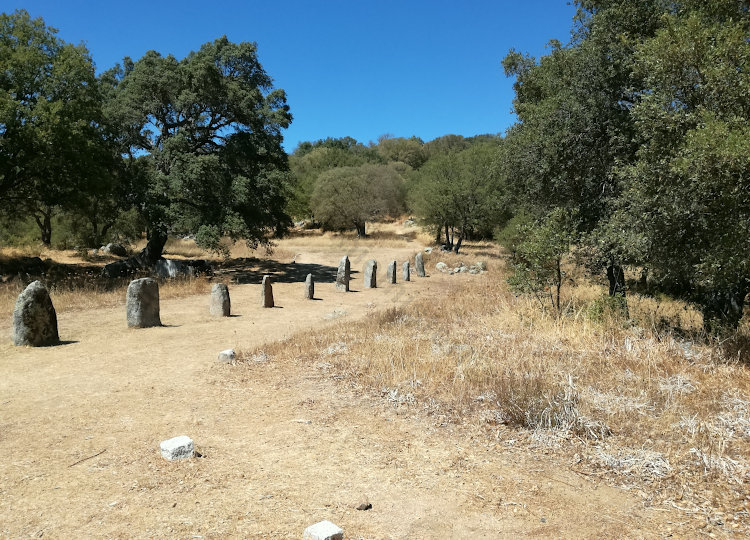
Pranu Muttedu of Goni: the menhirs of Sardinia and funerary cults
Also in Pranu Muttedu in Goni, the people of the Ozieri culture created an enormous open-air spiritual centre with numerous proto-anthropomorphic menhirs (3200-2800 BC)8. The monoliths were distributed in various ways: not only in rows with an east-west alignment, but also in groups of two or three, but especially near some monumental tombs. The burials consisted of lithic cysts or carved out of erratic boulders, and were accessed through entrances with orthostats or by crossing dromos corridors. Then, the burial chambers were enclosed within megalithic circles, called peristaliths, and finally accompanied by some sixty menhirs.
The tombs of Pranu Muttedu necropolis reveal a fundamental aspect of anthropomorphic megalithism in Sardinia, namely that the monoliths were in some way connected to the funerary sphere and related rites of passage. It was assumed that the burials housed some illustrious members of the community9, perhaps those same ancestors to whom the cult of the stone figures was addressed. Deified warriors, then, as seems to be confirmed by the rich grave goods found in Tomb V, which include obsidian weapons and fragments of a silver necklace.
Statue-menhirs of Sardinia and the image of the upturned
The last phase of the anthropomorphic evolution of Sardinian menhirs occurred in the Middle Calcolithic, around 2600-2400 BC. To the Filigosa culture and the later Abealzu period are attributed the monoliths carved in the shape of a man. They are therefore menhirs statues or stele statues, as they are made of slabs with a flat surface and fixed vertically. Archaeologists have found menhir statues all over the island, but mainly in the central historical regions: in Sarcidano, Marghine, Barigadu and Mandrolisai. Most of them are hosted in the Museum of Prehistoric Statuary in Sardinia, located in the Aymerich Palace in Laconi.
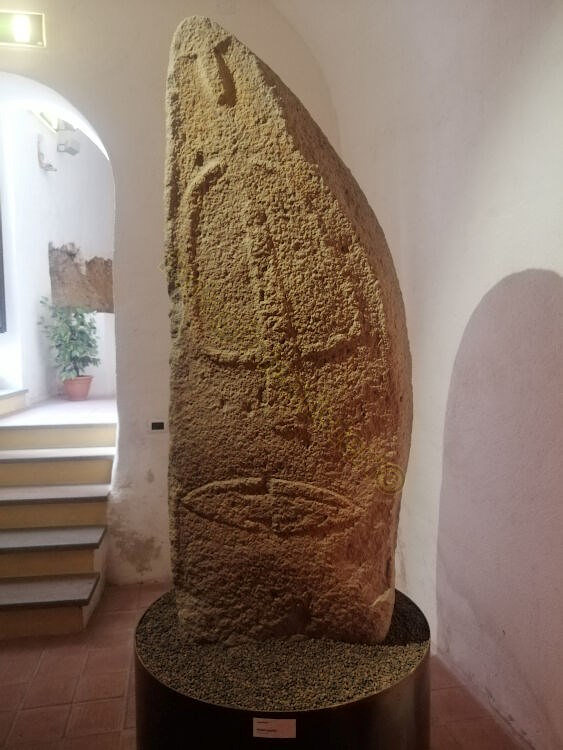
The abstract figures of the ancestors
Compared to the similar lithic representations from Lunigiana, or from other parts of the Europe, the menhirs of Sardinia are characterised by more blurred and abstract contours. The somatic traits, scarcely hinted at, take the form of a simple T-shaped stylisation of the nose and eyebrows of the face, without a mouth, and also the clothing details are essentially sculpted.
Therefore, the ancestors appeared austere and impersonal. The statues-menhirs expressed the idea of the warrior more than a precise figurative representation of him, they enclosed his essence by codified symbols. Thus, the reproduction of a horizontal double dagger, at abdomen level, was a sign of virility and strength and allowed the figure of a male hero to be impersonated. Rare were the female sculptures, perhaps images of exceptional wifes, identifiable by the presence of breasts. Such depictions were certainly linked to the cult of the mother goddess, as they contained symbolic motifs similar to those found in the domus de janas.

The upturned human figure
So, even Chalcolithic people associated ancestor worship with funerary rites of passage. In menhir-statues of the Sardinian Chalcolithic, the afterlife dimension of the deceased was expressed by the symbol of the upturned, a sculptural representation of similar rock petroglyphs. In fact, numerous sculptures were found with the depiction of an upturned, half-length man on the front, his arms open wide so that he looks like a candelabrum or a trident. The people of the Abealzu-Filigosa culture had the idea that the afterlife world was specular to the living one, inverted and complementary. The soul of the deceased turned from the sky to the earth, and in this way was manifested.
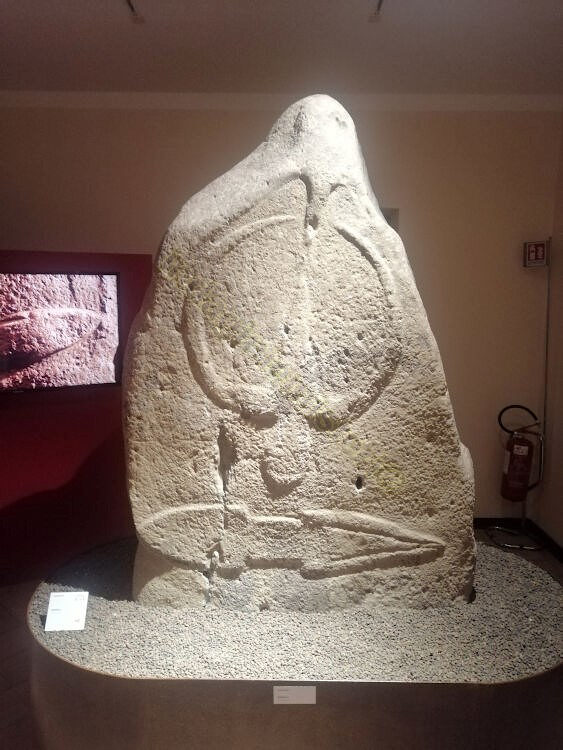
Then, the deceased received the protection of deified heroes who, as guiding spirits, led the soul to the afterlife10.
The double dagger
The dagger of the male statue-menhir is double, since it consists of two triangular blades pointing outwards. However, it is not clear if the left portion is just a handle, as it is sharper and lacks the ‘V’ sign that marks the opposite half. Then, the weapon would be not different from the copper one used by coeval cultures in Northern Italy, such as at Remedello11.
The propensity to emphasise the warlike aspect of the ancestor-heroes was certainly a sign that Sardinian Chalcolithic society was changing. As a symbol of conflict12, the double dagger perhaps reveals a growing rivalry between the people of the Abealzu culture and those of Monte Claro, who came from the south of Sardinia13. This could allow us to contextualise the territoriality of the statues-menhirs in Sardinia, whose spread is not uniform, but is mainly concentrated in the centre of the island.
The dawn of a new world
The double dagger, therefore, was the sign of the “construction of the warrior’s ideology”14. It expressed a new attitude: the governance of the territory was no longer only spiritual, ideal, as at the time of the first aniconic menhirs, but was now to be defended with weapons, it became a subject to be possessed.
The Chalcolithic introduced a new world in which the ancient Sardinians experienced an increase in resources, wealth and trade, but also conflicts and, since then, the arrival of new peoples from the sea. From the Europe came the peoples of Monte Claro and the later Campaniform culture. The space they belonged to therefore had to be guarded in its material component: megalithic enclosures were erected, as at Monte Baranta (2500 – 2200 BC), and stone buildings began to be constructed to control the territory and natural resources. These were the preconditions that led to the birth of a different cultural facies, which change Sardinia forever; at the dawn of a new world, the Nuragic civilisation arose.
Samuele Corrente Naso
Map of places
Notes
- M. Perra, Le statue antropomorfe prima dei nuraghi. Nel volume: A. Moravetti, P.Melis, L. Foddai, E. Alba, La Sardegna Preistorica, Corpora delle antichità della Sardegna, 2017, Carlo Delfino editore & C. ↩︎
- P. Melis, La religiosità prenuragica. Nel volume: A. Moravetti, P.Melis, L. Foddai, E. Alba, La Sardegna Preistorica, Corpora delle antichità della Sardegna, 2017, Carlo Delfino editore & C. ↩︎
- G. Lilliu, La civiltà dei sardi dal Paleolítico all’età dei nuraghi, Il Maestrale, 2004. ↩︎
- E. Atzeni, M.G. Melis, Villaperuccio tra ipogeismo e megalitismo. Testimonianze archeologiche dalla preistoria all’età romana, Comune di Villaperuccio/Università degli Studi di Cagliari, Villaperuccio, 2000. ↩︎
- M. A. Fadda, Civiltà arcaica del nuorese, in Archeologia Viva 134, 2009. ↩︎
- E. Atzeni, La scoperta delle statue-menhir. Trent’anni di ricerche archeologiche nel territorio di Laconi (a cura di G. Murru), Cagliari; Laconi. Il museo delle statue-menhir, «Sardegna Archeologica. Guide e Itinerari», 34, Sassari, 2004. ↩︎
- F. Campus, L. Usai, Sorgono. Complesso archeologico Biru ’e Concas, «Erentzias», 1, Notiziario, Sassari, 2001. ↩︎
- E. Atzeni, D. Cocco, Nota sulla necropoli megalitica di Pranu Mutteddu, Goni, in Atti 1989. ↩︎
- Ibidem note 1. ↩︎
- E. Atzeni, Le statue-menhir di Laconi, in Aa.Vv. 1978. ↩︎
- E. Atzeni, Le statue-menhir di Piscina ‘e Sali, Laconi-Sardegna, in Archéologie en Languedoc, n° 22, 1998. ↩︎
- Ibidem note 3. ↩︎
- F. Soula, Le pietre fitte dell’area corso-sarda. Studio sistemico dei territori, Università di Sassari, Tesi di Dottorato in Preistoria, 2012. ↩︎
- J. Guilaime, J. Zammit, Le sentier de la guerre. Visages de la violence préhistorique, Paris, 2001. ↩︎

